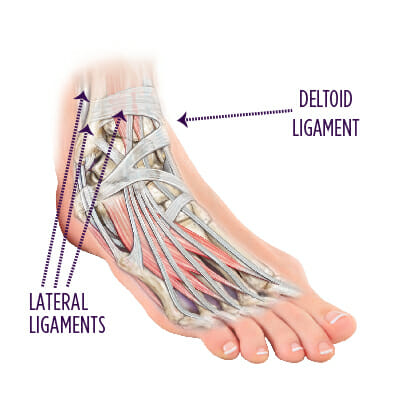
Anatomy of the Ankle
The ankle joint is made of a complex assortment of bones, muscles, tendons, and ligaments. On the medial (inside) side of the ankle, the deltoid ligament prevents the ankle joint from rolling out (eversion). Meanwhile, on the lateral (outside) aspect of the ankle, there are three separate ligaments that prevent the ankle from rolling in (inversion). If the ankle is stressed beyond its normal end range of motion, the ligaments can be sprained. Certain bones of the ankle and foot can become fractured if the injury is severe.
What are common symptoms?
Symptoms of an ankle sprain vary in presentation and severity, and this list should only be thought of as a generalization.
- Pain, swelling, and bruising
- May be difficult to bear weight on the injured leg, making it painful to walk.
The severity of your symptoms will depend on the degree of injury to the ligaments.
- First-Degree: Stretching of the ligaments without any tearing or significant laxity.
- Second-Degree: Stretching of the ligaments with partial tearing of the fibers, resulting in mild to moderate laxity.
- Third-Degree: Complete rupture of the ligaments and significant laxity.
How is an ankle sprain diagnosed?
A discussion of your symptoms, a physical examination, and X-rays are useful for a diagnosis. Your specialist may also recommend an MRI scan to evaluate for injuries to ankle cartilage or tendons around the ankle that can also be injured during an ankle sprain.
What are my treatment options?
You will want to treat your sprained ankle properly in order to prevent problems with instability and chronic pain down the road. Treatment typically prescribed by Summit Orthopedics physicians is as follows:
For a first degree sprain:
- Follow the R.I.C.E. acronym:
- Rest – avoid walking on your ankle
- Ice – will keep swelling down
- Compression – bandages will immobilize and support
- Elevation – keep ankle above heart
What can I expect my results to be after treatment?
Your ankle sprain is a ligament injury and needs rehabilitation. Otherwise, your ankle might not heal completely and could be susceptible to re-injury. There are three phases of recovery for all ankle sprains:
- First phase: rest, protect, and reduce swelling
- Second phase: restore flexibility, range of motion and strength
- Third phase: gradual return to straight-ahead activity, maintenance exercise
Once your ankle can bear your full weight, your Summit physician will prescribe exercises to strengthen your muscles and ligaments, and increase your flexibility, balance, and coordination. You may have your ankle taped or in a supportive brace for walking and running.
How long until I’m better?
Your recovery time depends on the severity of your sprain. But no matter what type of sprain you experience, rehabilitation is the key to strengthening and protecting your ankle from future injury. Without rehabilitation, your ankle may cause chronic pain and instability, and you may develop arthritis. Let your Summit foot and ankle specialist know if your ankle still hurts even after rehabilitation. They will examine you to make sure the sprained ligament has healed correctly and that there is not some other injury causing problems.
To prevent future sprained ankles, stay in shape and maintain good muscle balance, flexibility, and strength in your soft tissues. Pay attention to your body’s warning signs to slow down when you feel pain or fatigue.
